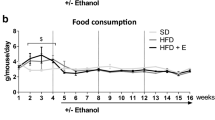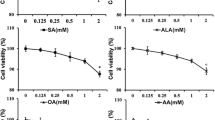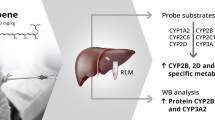Summary
Background Long-term ethanol consumption in laboratory animals is associated with histological alterations of liver cells and modifications of fatty acid metabolism.
Aim of the study The present study was aimed at investigating the effect of 1- and 2-month chronic treatment of rats with ethanol on the metabolism of two unsaturated (oleic and linoleic) fatty acids in liver and kidney microsomes, in relation to the CYP2E1 enzyme content in both tissues.
Methods Rats were fed ethanol (14 g/Kg/d) or dextrose through a permanently implanted gastric cannula, as described in the intragastric feeding rat model for alcoholic liver disease (ALD). CYP2E1 level was immuno-quantified in both liver and kidney microsomes by Western blot, whereas faty acid ω- and (ω–1)-hydroxylations were measured using HPLC and radiometric analytical methods.
Results One- and two-month ethanol treatment led to a 3- to 4-fold rise of the CYP2E1 protein in both liver and kidney microsomes. Oleic and linoleic acid (ω–1)-hydroxylations were increased (∼3-fold) in liver microsomes after one-month of ethanol administration, but surprisingly such a rise was not observed after a two-month treatment; on the other hand, no effect was observed on the ω-hydroxylations of these fatty acids. Furthermore, as previously described for lauric acid, ethanol intake did not significantly act on the kidney microsome capability to hydroxylate unsaturated fatty acids.
Conclusions CYP2E1 is strongly inducible by ethanol and therefore accounts for the tolerance for this hepatotoxicant. Our results support the development of an adaptation process in the liver hydroxylating enzyme system, which occurs between one and two months of ethanol feeding. Although it is usually not appropriate to extrapolate animal findings to humans, rat and human CYP2E1s were observed to have comparable specificities and similar mechanisms of regulation. Thus, the present study allowed the acquirement of detailed information of CYP2E1 activity in patients with severe manifestations of ALD.
Similar content being viewed by others
Author information
Authors and Affiliations
Additional information
Received: 12 April 2000, Accepted: 23 August 2000
Rights and permissions
About this article
Cite this article
Amet, Y., Plée-Gautier, E., Berthou, F. et al. Adaptation to chronic ethanol administration emphasized by fatty acid hydroxylations in rat liver and kidney microsomes. Eur J Nutr 39, 270–276 (2000). https://doi.org/10.1007/s003940070006
Issue Date:
DOI: https://doi.org/10.1007/s003940070006




